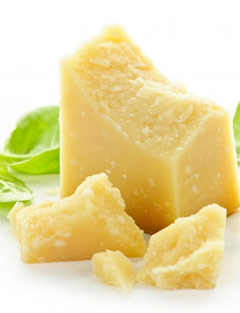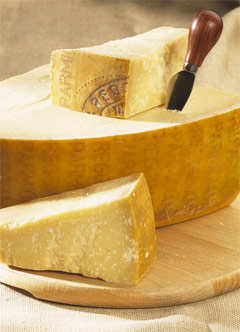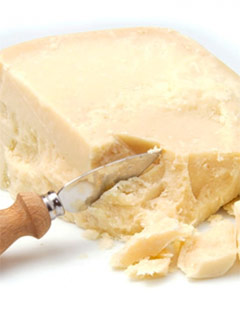|
|
Parmesan Cheese: One of the Most Expensive Super Food

Parmesan cheese is known as King of cheeses.
Parmesan cheese is the name of a few kinds of Italian extra-hard cheeses made of
cow's milk. It is usually the cheese to go with Spaghetti and other typical
Italian pasta, but it also has many other uses. Parmesan is a part of Italian
national cuisine and is usually grated.
Usually, Parmesan cheese is either Parmigiano-Reggiano or Grana Padano cheese.
Both cheeses are AOC. This means that the way they are made, and the region they
come from are strictly regulated. Only these brands (Parmigiano Reggiano, Grana
Padano) are protected. In many parts of the world, cheese is sold as Parmesan
cheese that has nothing to do with the true (Italian) Parmigiano Reggiano or
Grana Padano. The biggest producers of such cheeses are the United States and
Argentina. The original Parmesan cheese is one of the most expensive cheeses in
the world.
Parmigiano-Reggiano called Parmesan in English after the French name for it, is
a hard, granular cheese, cooked but not pressed, named after the producing areas
near Parma, Reggio Emilia, Modena, and Bologna (all in Emilia-Romagna), and
Mantova (in Lombardia), Italy. Under Italian law, only cheese produced in these
provinces may be labelled "Parmigiano-Reggiano", and European law classifies the
name as a protected designation of origin.
Parmigiano is the Italian adjective for Parma. Reggiano is the Italian adjective
for Reggio Emilia. The name Parmesan is used for cheeses which imitate
Parmigiano-Reggiano, with phrases such as "Italian hard cheese" adopted to skirt
legal constraints.
Parmigiano-Reggiano is made from raw cow's milk. The whole milk of the morning
milking is mixed with the naturally skimmed milk (which is made by holding milk
in large shallow tanks to allow the cream to separate) of the previous evening's
milking, resulting in a part skim mixture. The milk is pumped into copper-lined
vats (copper heats and cools quickly). Starter whey is added, and the
temperature is raised to 33�35 �C (91�95 �F). Calf rennet is added, and the
mixture is left to curdle for 10�12 minutes.
The curd is then broken up mechanically into small pieces (around the size of
rice grains). The temperature is then raised to 55 �C (131 �F) with careful
control by the cheese-maker. The curd is left to settle for 45�60 minutes. The
compacted curd is collected in a piece of muslin before being divided in two and
placed in molds. There is 1100 L (291 US gallons or 250 imperial gallons) of
milk per vat, producing two cheeses each. The curd making up each wheel at this
point weighs around 45 kg (100 lb). The remaining whey in the vat was
traditionally used to feed the pigs from which "Prosciutto di Parma" (cured
Parma ham) was produced. The barns for these animals were usually just a few
yards away from the cheese production rooms.
Parmigiano-Reggiano is commonly grated over pasta dishes, stirred into soups and
risottos, and eaten on its own. It is often shaved or grated over other dishes.
Slivers and chunks of the hardest parts of the crust are sometimes simmered in
soup. They can also be just roasted and eaten as a snack. The hollowed-out crust
of a whole wheel of Parmigiano can be used as a serving pot for large groups.
 According to legend, Parmigiano-Reggiano was created in the course of the Middle
Ages in Bibbiano, in the province of Reggio Emilia. Its production soon spread
to the Parma and Modena areas. Historical documents show that in the 13th and
14th centuries, Parmigiano was already very similar to that produced today,
which suggests its origins can be traced to far earlier. According to legend, Parmigiano-Reggiano was created in the course of the Middle
Ages in Bibbiano, in the province of Reggio Emilia. Its production soon spread
to the Parma and Modena areas. Historical documents show that in the 13th and
14th centuries, Parmigiano was already very similar to that produced today,
which suggests its origins can be traced to far earlier.
Parmigiano has many aroma-active compounds, including various aldehydes and
butyrates. Butyric acid and isovaleric acid together are sometimes used to
imitate the dominant aromas. Parmigiano is also particularly high in glutamate,
containing as much as 1.2 g of glutamate per 100 g of cheese, making it the
naturally produced food with the second highest level of glutamate, after
Roquefort cheese. The high concentration of glutamate explains the strong umami
taste of Parmigiano. Parmigiano cheese typically contains cheese crystals,
semi-solid to gritty crystalline spots that at least partially consist of the
amino acid tyrosine.
The name is trademarked and, in Italy, legal exclusive control is exercised over
its production and sale by the Parmigiano-Reggiano cheese Consorzio, which was
created by a governmental decree. Each wheel must meet strict criteria early in
the aging process, when the cheese is still soft and creamy, to merit the
official seal and be placed in storage for aging. Because it is widely imitated,
Parmigiano-Reggiano has become an increasingly regulated product, and in 1955 it
became what is known as a certified name (which is not the same as a brand
name). In 2008 an EU court determined that the name "Parmesan" in Europe only
refers to Parmigiano-Reggiano and cannot be used for imitation Parmesan.
Nutritional Benefits of Parmesan
The nutritional benefits of Parmesan are such that it should rightly be regarded
as a 'super-food'. Cheese contains all the goodness of milk but in a
concentrated form - 16 litres of milk are required for every kilo of Parmesan.
One of the factors that make Parmesan so 'super' is the ease with which the
human digestive system can assimilate all this goodness. Due to its long ageing,
much of the protein in Parmesan has been broken down into peptones, peptides and
free amino acids, in effect the protein has been 'pre-digested'; the protein is
readily available and as such it puts very little strain on the metabolism.
Parmesan contains 33% protein compared to 20% in lean beef and that animal
protein takes 4 hours to digest while the protein in Parmesan takes just 45
minutes. Other benefits to the digestion include Parmesan's ability to promote
the development of Bacillus Bifidus, which is useful for the maintenance of a
healthy gut, and also the fact that there is no lactose present - good news for
the lactose intolerant or those with gastro-intestinal inflammation.
The fat content of cheese often causes alarm to the health conscious but it is
important to note that fat is a fundamental part of nutrition. Muscular activity
is dependent on fatty acids and, again, because of the changes that occur during
the ageing of Parmesan, much of the fat is in the form of short-chain fatty
acids, these compounds are absorbed more easily and supply energy very quickly
to the body; in fact, they are treated by the body in much the same way as
glucosides (sugar).
The cholesterol content of Parmesan is only 80 - 85mg/100g, much lower than
other full fat cheeses. Exponents of preventative medicine take an unfavourable
view of this sterol but a daily intake of 300mg is beneficial according to
health guidelines so cholesterol should not be seen as a limiting factor in the
consumption of Parmesan.
This combination of nutritional benefits explains why in Italy doctors recommend
Parmesan to infants and the elderly as well as to athletes.
 A 30 gram serving of Parmisan Cheese provides 195 mg of phosphate. A 30 gram serving of Parmisan Cheese provides 195 mg of phosphate.
Parmesan is a traditionally aged cheese that is rich in Protein and also
virtually Lactose Free. This makes parmisan a good choice for those who struggle
with lactose tolerance. A 30 gram serving will boost your phosphate intake by
one third, and also provide you with a quality amount of calcium which is shown
to regulate body fat storage. Phosphate is essential in the metabolism of
carbohydrate, and is widely distributed in cell membranes. Is is also required
for muscle contraction and the mineralisation of your teeth and bones.
One oz. of grated Parmesan cheese provides 11 g protein and just 1 g
carbohydrates. The cheese is a source of bone-building minerals calcium and
phosphorus. A 1-oz. serving of grated cheese provides 31 percent of the
recommended dietary allowance for calcium and 20 percent for phosphorus. Other
vitamins and minerals offered by the cheese include 11 percent of the RDA for
vitamin B12, 7 percent for zinc and selenium and 8 percent for riboflavin.
Weight Management
If you are watching your weight and trying to make low-calorie foods more
palatable, adding Parmesan cheese can be an asset. Parmesan is a flavorful
cheese, so you do not have to use a large serving to enhance your foods. While 1
oz. of grated Parmesan contains 120 calories and 8 g fat, similar to other hard
cheeses, 1 tbsp. grated Parmesan cheese contains just 22 calories and 1 g fat.
One tablespoon is enough to enhance the flavor of roasted vegetables and salads.
Lactose Intolerance
Despite being a dairy product, Parmesan is a low-lactose food. If you must
avoid dairy due to an intolerance to the sugar in milk, you may be able to
consume small amounts of Parmesan cheese. If you are severely lactose intolerant
or have a milk allergy, check with your doctor or dietitian before indulging.
Parmesan cheese contains 428 mg sodium per 1-oz. serving. The Institute of
Medicine recommends keeping your sodium intake below 1,500 mg daily. Moderate
1-tbsp. servings contain just 76 mg, however. Parmesan cheese's quality varies
widely. Choose high-quality Parmigiano-Reggiano and grate your own to attain the
best flavor and texture.
Parmesan cheese is a complete protein containing all nine amino acids and packs
38 grams of protein per 1 cup serving (or 100 grams). Saturated fat is at 17
grams, and saturated animals fats are the kinds of fats you actually want to
consume. Saturated fats are especially important for growing children, and my 5
year old is growing like a weed these days.
The calcium content is just amazing, 1109 mg. per 1 cup serving. That�s more
than the RDA of calcium per day, for an average adult, and for a child it�s
between 500-800 mg. per day. A half a cup serving of parmesan is better than
having him take a calcium supplement, it�s real nutrient dense food. The best
supplement to one in getting enough nutrients into one�s body is through food,
not supplements. There are several other trace vitamins and minerals present in
this fabulous cheese, but by far calcium is king.
Parmesan cheese is a popular hard cheese used in salads and pasta dishes.
Because of its intense flavor, a little bit of Parmesan can go a long way,
making it easier to eat in moderation. If you get migraine headaches, it�s
important to know that aged cheeses like Parmesan are a common trigger. Since
most cheeses are high in sodium, people with high blood pressure should eat only
moderate amounts and factor the sodium content into their daily totals. Some
people with IBS are sensitive to dairy and experience discomfort after eating
it.
Video
Dated 28 November 2013
|
|
|
|
|









